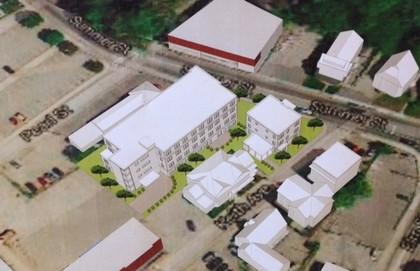Barre City, Vermont Accounts for Climate Change within a Brownfield Redevelopment Plan
 Graphic representation of proposed Central Vermont Community Land Trust Remediated brownfields campus.The Summer Street Housing Limited Partnership, a partnership between the Central Vermont Community Land Trust (CVCLT) and the non-profit Housing Vermont, sought to redevelop a brownfields
Graphic representation of proposed Central Vermont Community Land Trust Remediated brownfields campus.The Summer Street Housing Limited Partnership, a partnership between the Central Vermont Community Land Trust (CVCLT) and the non-profit Housing Vermont, sought to redevelop a brownfields![]() brownfieldsWith certain legal exclusions and additions, the term "brownfield site" means real property, the expansion, redevelopment, or reuse of which may be complicated by the presence or potential presence of a hazardous substance, pollutant, or contaminant. site in Barre, Vermont. The site was the former location of an automobile servicing station and a paint shop, and previously contained several underground petroleum storage tanks.
brownfieldsWith certain legal exclusions and additions, the term "brownfield site" means real property, the expansion, redevelopment, or reuse of which may be complicated by the presence or potential presence of a hazardous substance, pollutant, or contaminant. site in Barre, Vermont. The site was the former location of an automobile servicing station and a paint shop, and previously contained several underground petroleum storage tanks.
To guide the redevelopment efforts, the partnership conducted an Analysis of Brownfields Cleanup Alternatives (ABCA). As part of its analysis – and to build in climate resiliency and adaptation – the partnership used available regional climate projections to anticipate current and future risks; namely flooding and extreme temperatures. The partnership then considered the vulnerability of potential cleanup remedies to the identified climate risks.
By including current and future climate threats in its analysis, the partnership was better able to understand potential vulnerabilities associated with its planned brownfields investment. For example, the increasing frequency and intensity of storms projected for the region may lead to flooding that could compromise potential remediation fixes such as engineered caps. By its explicit consideration of projected climate threats, now and in the future, the Partnership's final remedy selection is designed to safeguard public health even as the climate changes.
How Did They Do It? |
Applicable EPA Tools |
|---|---|
|
Identified climate risks
|
Review the National Climate Assessment regional projection to better identify projected climate risks. |
|
Considered climate risk and vulnerability when evaluating cleanup alternatives
|
Use the EPA's Analysis of Brownfields Cleanup Alternative checklist to help consider anticipated climate changes in your Corrective Action Plan. |
|
Selected a Brownfield Cleanup Alternative that they identified as having Adaptive Benefits
|
Use EPA Brownfield Revitalization in Climate-Vulnerable Areas to help inform selection of appropriate adaptation option. |
Similar Cases and More Information
The Summer Street Housing Limited Partnership anticipated the effects of climate change to their brownfield redevelopment efforts. To see how waste sites (Superfund or RCRA sites) have prepared for climate changes see American Cyanamid Superfund case.
References
- NOAA Technical Report on Regional Climate Trends and Scenarios for the United States National Climate Assessment: Part 1. Climate of the Northeast United States (PDF)(87 pp, 5.5 MB, About PDF)
- Analysis of Brownfield Cleanup Alternatives
- Corrective Action Public Notice (PDF)(1 pg, 43 K) Exit
- Vadose Zone Leaching (VLEACH)

